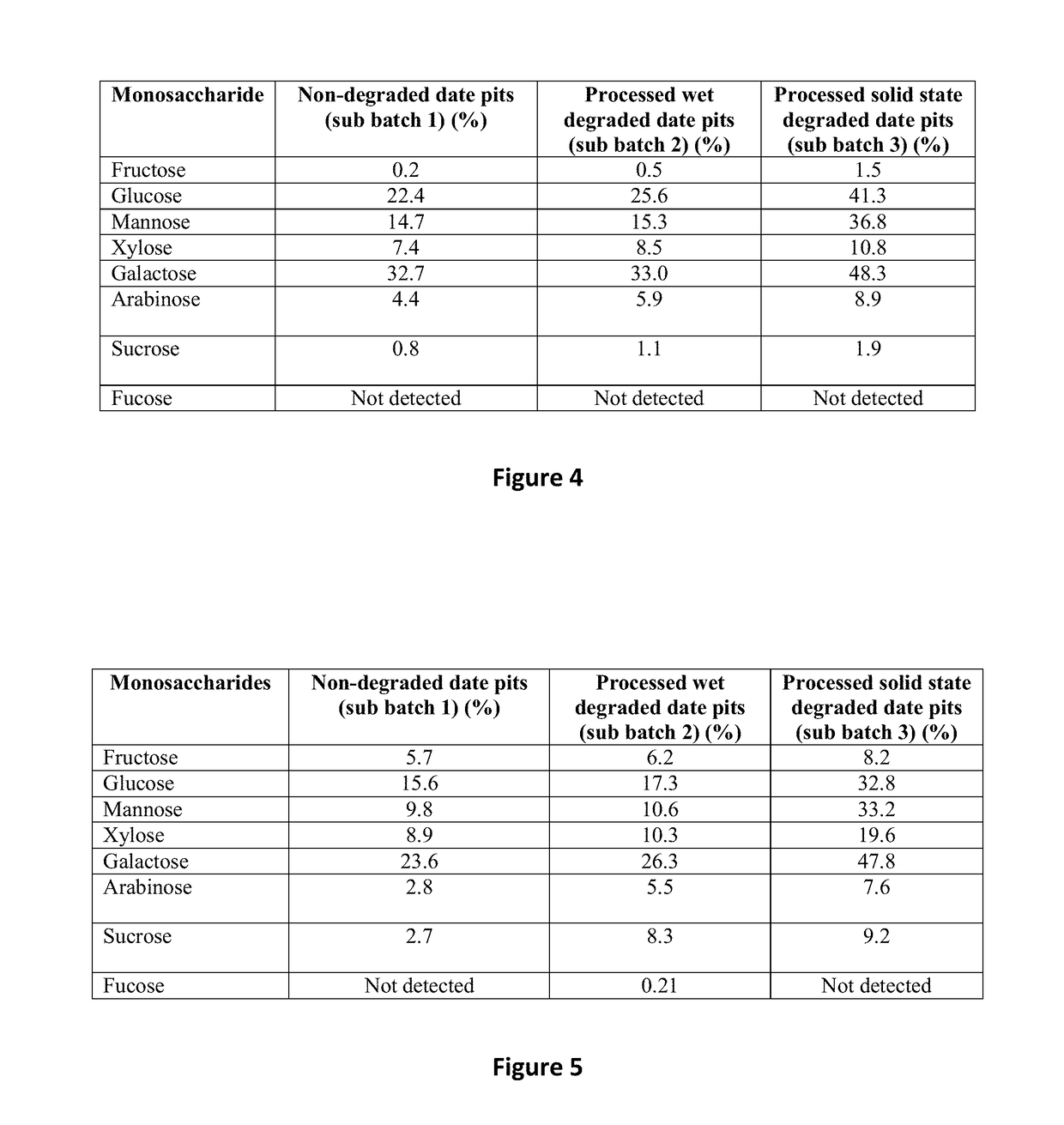Antibacterial Peptide and Method of Treatment Using the Antibacterial Peptide
a technology of antibacterial peptide and antibacterial peptide, which is applied in the field of antibacterial peptide, can solve the problems that feed composition costs make a large proportion of animal production costs, and achieve the effect of treating and preventing bacterial infections in domestic animals
- Summary
- Abstract
- Description
- Claims
- Application Information
AI Technical Summary
Benefits of technology
Problems solved by technology
Method used
Image
Examples
example 1
Preparation of Fungus Culture
[0082]Trichoderma reesei is grown on potato dextrose agar (PDA) at 25+2 oC for 7 days in the dark.
[0083]To confirm that the fungi could degrade the date pits a ground date pits based inoculum was prepared by adding half a kilogram of ground date pits and 150 ml of distilled water into 1 liter flasks. The flasks were autoclaved at 121 oC for 30 min on 3 consecutive days. Under aspetic conditions the ground date pits were then inoculated with 8 agar plugs (6 mm diameter) from actively growing margins of the Trichoderma reesei colony. The flasks were incubated at 25+2 oC in the dark for three weeks. The flasks were shaken occasionally to ensure uniform colonisation of the date pits by the fungi. Colonized ground date pits which had been autoclaved twice served as a control.
[0084]Small amounts of the colonised and control ground date pits were plated onto PDA to confirm that T. Reesei was present or absent, respectively.
Preparation of Fungi-Degraded Date Pit...
example 2
Methods
[0115]A batch of 100 kg of the Khals variety of date pits was obtained from Al Foah date factory, PO Box 18454, Al Ain, United Arab Emirates.
[0116]The date pits were divided into three separate sub batches, namely: sub batch 1, sub batch 2 and sub batch 3.
[0117]Sub batch 1 comprises non-degraded date pits which act as a control batch. The non-degraded control (sub batch 1) was not treated with the fungus Trichoderma reesei and was used for comparison purposes, as will become clear from the paragraphs below. Samples or aliquots were taken from the non-degraded control (sub batch 1) for the purpose of chemical analysis, electron microscopy evaluation and bacteriological studies, respectively, as will be set out more fully below.
[0118]Sub batch 2 comprises degraded date pits degraded by a wet degradation method described in Belal IEH, “Evaluation fungi-degraded date pits as a feed ingredient for Nile tilapia Oreochromis niloticus L”, Aquaculture Nutrition, 2008, vol. 14, pages 4...
example 3
Analysis of Peptides Obtained from Sub Batch 1, Sub Batch 2 and Sub Batch 3
[0155]Three samples were collected from sub batch 1, sub batch 2 and sub batch 3, respectively. More specifically, sample 1 (non-degraded date pits sample) was collected from sub batch 1, sample 2 (Belal 2008 sample) was collected from sub batch 2 and sample 3 (solid state degradation sample) was collected from sub batch 3.
Extraction of Peptides
[0156]Peptides were isolated from sample 1, sample 2 and sample 3 and were characterised by the method of Siow and Gan, 2013 (Hwee-Leng Siow, Chee-Yuen Gan 2013). Extraction of antioxidative and antihypertensive bioactive peptides from Parkia speciosa seeds. Food Chemistry 141:3435-3442).
[0157]In respect of each of sample 1, sample 2 and sample 3, degraded date pits powder obtained from grinding the samples, was treated with phosphate buffer (10 millilitre, pH 8.0) and different substrate-to-enzyme ratio of alcalase enzyme (20 and 50). The suspension was then incubated...
PUM
| Property | Measurement | Unit |
|---|---|---|
| molecular mass | aaaaa | aaaaa |
| molecular mass | aaaaa | aaaaa |
| molecular mass | aaaaa | aaaaa |
Abstract
Description
Claims
Application Information
 Login to View More
Login to View More - R&D
- Intellectual Property
- Life Sciences
- Materials
- Tech Scout
- Unparalleled Data Quality
- Higher Quality Content
- 60% Fewer Hallucinations
Browse by: Latest US Patents, China's latest patents, Technical Efficacy Thesaurus, Application Domain, Technology Topic, Popular Technical Reports.
© 2025 PatSnap. All rights reserved.Legal|Privacy policy|Modern Slavery Act Transparency Statement|Sitemap|About US| Contact US: help@patsnap.com



